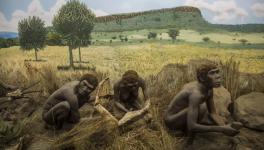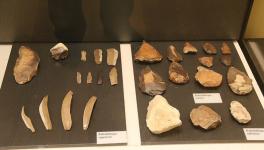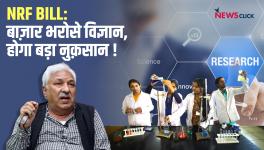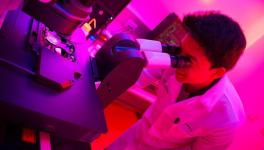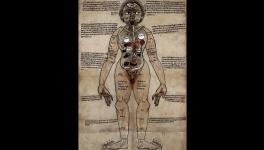US Supreme Court Strikes Down Natural Gene Patents
Newsclick discusses with Dr. Satyajit Rath from the National Institute of Immunology the US Supreme Court's ruling on gene patenting. The judgement comes in two parts. One, natural genes cannot be patented. And two, cDNAs that are created by naturally occurring enzymes are patentable. Dr. Rath says that the Supreme Court has taken a narrow view of what a gene is, thus creating ambiguity around the subject. Also, whether the database of information collected by Myriad Genetics over the years will remain the company's property or be made accessible to others is a big question.
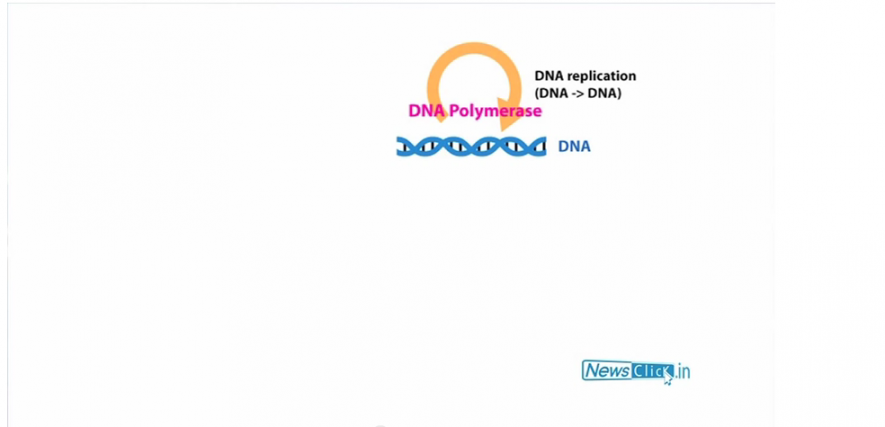
Prabir Purkayastha (PP): Hello and welcome to Newsclick. Today we have with us Dr. Satyajit Rath of National Institute of Immunology and we are going to discuss, US Supreme Court judgement on Human gene patenting. Satyajit, two parts to this judgement. One is that it is accepted that natural genes cannot be patented; it comes under what is called the 101 exception which is natural laws etc., cannot be patented. But it has talked about something called cDNA which is patentable; we will come to that issue later. The first part, the human genes cannot be patented. A big advance?
Satyajit Rath (SR): If you look at it, it is a huge change, not simply for the issue of gene patenting. It is, of course, a major issue for gene patenting. No question about that. But the wording of the Supreme Court Judgement almost directs patent authorities to go beyond genes and to say that simply discovering, isolating a natural molecule is not sufficient for patentability under the USC 101 clause. Now, I can argue that, that is true of drug molecule that is discovered from nature, from plant sources, from microbes, from sea weed, from whatever. After all, a very large proportion of our drugs come from natural product sources. The breast cancer drug Taxol is perfectly good example. So it now becomes possible to make the argument that it's not simply gene patenting that has been invalidated by the US Supreme court, but all naturally occurring molecules of any utility in and of themselves cannot be patented. I am not sure that this is how subsequent litigation which is inevitable is going to read it. But the current wording of the Supreme Court judgement opens this door.
PP: Even if you don't go through that door, I think that Supreme Court's intention was not to be so revolutionary, because they discussed during the oral testimonies various things and one of those things was of course, the plant extract. But looking at the gene patent which has been disallowed, which means that all genes will not be patentable, that may not be such an important issue, because gene patenting is really going to expire; the genes were discovered before the human genome project came out with the results. So roughly, another two-three years, it is going to expire. But the important part of it is also, that, any information naturally occurring in such substances would not be patentable, which was at the core of the gene patenting, because in some sense, it was the information coded by the gene and this means that it would also be the micro organisms founded in nature, it would be all other natural occurring information which is there in genes as well as segments of genes. So, a whole bunch of things are not going to be patentable after this, even if we see it narrowly, not widen it as you were suggesting it could be.
SR: So as a matter of fact, the reason I bring up the wider implications is that the implication that you are talking about, it's not clear the Supreme Court judgement permits that. The Supreme Court has taken an extremely narrow view of what a gene is. It has said, it's a sequence. It has not said anything about the information content implicit in the sequence. Which is why, it makes a distinction between that sequence and the cDNA which we can talk about later but the cDNA made from that sequence. Informationally, those are very closely allied. Yet, the Supreme Court has made a distinction between those and the only real way of interpreting that is that the Supreme Court is not judging information content for the USC101 patentability conditionalities. It is actually judging the literal sequence. Nonetheless, it is not simply the BRCA1, BRCA2 that are at stake. Those will expire in two years time in any case. There are in excess of 3000 gene patents, out there already, which are going to be affected by this judgement because that many have been issued. It is true that pure gene patenting as a strategy has been declining over the past ten years. I think ten years ago as many as 40% of gene patenting who have natural sequences. Today, less than 10% of sequences patented are natural. So there is a decline. Nonetheless, that's a large number and those are all patents that are far more recent. So all of those are going to be affected in one way or another.
PP: And also for naturally occurring genes in plants, animals and so on. So the numbers are not just human genes but also much larger than that. And also in the future such patents would not be possible to be issued. We have really got back into the situation which the Diamond versus Chakraborty case really opened out, which is that it allowed artificially occurring life forms, in that case it was an oil eating microbe which Chakraborty had engineered. Supreme Court has really come back to this position saying that artificial genes OK, naturally occurring genes NO and it does not therefore also strike down any artificial life form patenting which the European Union had some problems with and the Indian patent law certainly doesn't allow.
SR: Yes, that's correct, in so far as that goes. But as I keep saying repeatedly, I am not sure that the US Supreme Court has understood in it's judgement in a legally interpretable fashion what they mean by a gene and that opens up all sorts of ambiguities where it is guaranteed that there will be litigation.
PP: That's an interesting point that you are making. So let's come immediately to the cDNA
SR: Absolutely.
PP: It allowed cDNA patent to be argued as to be patentable. It didn't say that we see that there could be other challenges to it. It could be obvious, it could be not novel and so on. So they opened it out to saying that we are only talking about patentability vis-a-vis 101. First, what is cDNA for our audience. What is the difference between cDNA and what the Supreme Court has held to be naturally occurring DNA.
SR: So, here is the issue. In simple terms, cDNA is a sequence. Let me go back to the original gene in the gene that is naturally occurring and that is not patentable. Under ordinary circumstances, what you have in the human genome, the gene that codes for a particular protein consists of a sequences of individual chemicals called nucleotides, of which, there are four kinds. And three nucleotides in a series codes for one particular amino acid in a sequence. So one amino acid after another, therefore each three nucleotide set codes for one amino acid. That's how from a nucleotide sequence you can derive an amino acid sequence for a protein. That's by way of the central dogma of biology as it is irritatingly called.
PP: First, we have the DNA that produces the RNA
SR: So, let me come to the RNA. In your DNA, most protein genes are present as split pieces. You have, let us say, ten amino acids, then you have a gap where there is a nucleotide sequence but it doesn't code for amino acids. It has other functions. Then you have another, say thirty amino acid code, then you have a gap. So if you simply make RNA from this DNA, this RNA is also interrupted as in terms of its information content. So the RNA is processed and all the bits that have been transcribed from the DNA that doesn't code for amino acids are cut out and a spliced RNA stretch is created and that goes out and from that as a template amino acids.
PP: This is all naturally occurring.
SR: This is all naturally occurring. However, the spliced RNA is therefore a sequence that in the literalist rendering of the Supreme Court's view, is not present in the DNA. Now, it's present as RNA.
PP: It's still naturally occurring RNA.
SR: It's still naturally occurring RNA. But you can take that RNA and you can build a complementary DNA. RNA and DNA differ in one of the four types of nucleotide chemicals that are used to synthesise them. The cDNA therefore, in Supreme Court's view is unnatural.
PP: It's done by laboratory technicians.
SR: It's done by laboratory technicians and it is not present. The cDNA of BRCA1 and BRCA2 is never present in nature and therefore passes the USC101 patentability criteria. That's the Supreme Court judgement. This is why, I am repeatedly saying it is a very literalist judgement.
PP: What's the problem with this interpretation of the cDNA. Is the cDNA really not naturally occurring?
SR: So, the way cDNA is made is by using a naturally occurring enzyme, an enzyme that comes from some bacteria and similar enzymes that are called reverse transcriptases because they make DNA from RNA rather than making RNA from DNA and number of micro organisms use this enzymes for natural processes. So clearly, making DNA from RNA templates is not unnatural.
PP: All retroviruses do that.
SR: All retroviruses do that. How accurately they do that is altogether a different problematic. But retroviruses do that. Many other organisms also use reverse transcriptases. The Supreme Court therefore is not saying that there is no such thing as cDNA in nature. The Supreme Court is saying something far more specific. They are saying there is no BRCA1, BRCA2 cDNA in nature and because there is no BRCA1 BRCA2 cDNA, it is a laboratory technician creation and therefore passes 101 and which is why I am coming back to my original point that the Supreme Court has dealt with the sequence as though it is a literal sequence rather than a sequence carrying information. That the informational content of the RNA being transcribed to DNA, it has come from one form of DNA it has come to a form of RNA, it goes to another form of DNA- this is all part of a natural predictable process. If you simply look at it as an information content it is an issue US Supreme Court has not taken into account.
PP: Most of the scientific researchers in the area have called it that they would really fail a student who produced a report like this and Judge Scalia actually made an almost similar point saying he agrees with the broad judicial understanding of what's being given as a report. But the biology of it, he thinks that he knows is of bogus, that he neither understands it, literally implies that the judges haven't understood it either. So looking at the science of it, thus seem, the science is very dicey or sketchy, if you will, and it seems to me that the intention is to protect the biotechnology industry in the United States which has made a lot of investment and the fear, the argument that this would really effect the innovation and also the fact that the Obama administration really also presented the same argument in the court saying cDNA is patentable and DNA is not patentable. So do you see this as really a victory of economics over science.
SR: Well, as I said, if you treat it in the literal sense that the Supreme Court did treat it, it's sort of hangs together, consistently. The real difficulty is we didn't forget when this comes into the domain of public discourse, that to be fair to the Supreme Court, they are really talking about USC101 conditionalities. They are not judging on other matters and consequences might turn out to be very odd. So for example, there are anecdotal stories floating around that Monsanto is very happy with this judgement. Why is Monsanto happy with this judgement? Monsanto, if apocrypha are to be believed, Monsanto has reason to be happy with the judgement because Monsanto is not in the business of selling genes, Monsanto is in the business of selling seeds and what Monsanto does is tinker with the genome of crop A, crop B, Crop C and engineer it and sell it. Now, if people could start and continue to patent genes from crops that Monsanto was tinkering with, Monsanto's ability to take crops and to tinker with them would be limited. Therefore this is a judgement that Monsanto sees as to its advantage in commercial terms. It's not at all my suggestion that this is what Monsanto thinks. I am simply saying. There is apocrypha out there that says this. It is an interesting light, regardless of it's true or not on the twisted ramifications that the judgement will have when it actually collides with the real world of commercial strategisation of multi nationals.
PP: It is clear that a certain section of scientific community, researchers and probably even companies were unhappy with the idea of genes being patented because that forbids further research and makes it a prerogative of just one company. So one can argue, that really, in this larger sense, science has tried to open it out to …
SR: No question about that. But apropos of that, let us keep in mind something that we have not won for seventeen years, sixteen years whatever it has been. Myriad has held the BRCA1, BRCA2 gene patents which means they are the only people who have been collecting information on BRCA1, BRCA2 mutation distribution in communities. They therefore built an unparalleled database of information. This database nobody has had access to, because they held the patents. Today, the patents are invalidated but is the database still their property and if it is, how do we resolve this peculiar situation that has emerged, which says that they have collected database under an exclusive claim that actually has never been enforced, according to the Supreme Court. I understand that we don't go back retrospectively and penalise, and so on and so forth. If the database is still information that's available and it is certainly in the public interest to have that database become accessible. There are many fights that we have not yet won, even though having the US Supreme Court come down very clearly saying that gene sequences fulfil the exclusion condition of USC101, is a victory in itself.
PP: So, limited victory but nevertheless a victory. For the future, lots of fight still remain.
SR: I will therefore come back to my original point once again. This is a victory that people in the public interest, people fighting in the public interest, activists in the public interest should be using to apply to non-DNA naturally occurring bio-molecules because that will open up a whole new category of litigation. It's not that the pharma industry is not aware of this. A very large amount of the concern in the pharma industry is precisely on this matter. There is no reason that this should not be held to the test of litigation.
PP: Well, let us first congratulate American Civil Liberties Union for taking up this case, the Public Patent Foundation, the two organisations who fought it and the scientific community which stood with them in order to break-open this case and I think we need to see much more on this in the future. Thank you very much Satyajit. We will continue to watch this area because I think this is now going to open out in different ways, even though life-form patenting in the US still continues and artificial genes can be patented as Monsanto, as you said, is delighted in this part of it that still continues which is not possible in India and in many other countries. Thank you very much.
Get the latest reports & analysis with people's perspective on Protests, movements & deep analytical videos, discussions of the current affairs in your Telegram app. Subscribe to NewsClick's Telegram channel & get Real-Time updates on stories, as they get published on our website.












